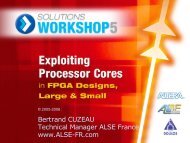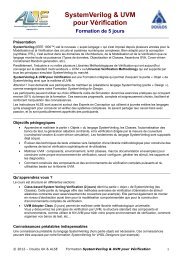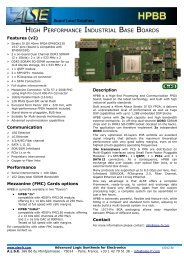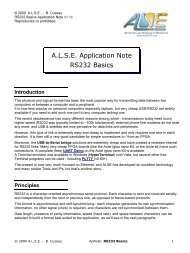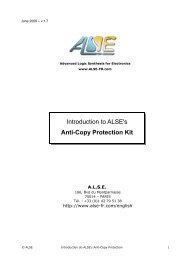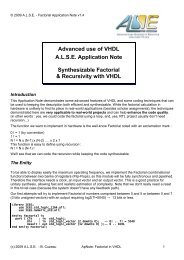Design & Coding Style Guide - ALSE
Design & Coding Style Guide - ALSE
Design & Coding Style Guide - ALSE
You also want an ePaper? Increase the reach of your titles
YUMPU automatically turns print PDFs into web optimized ePapers that Google loves.
<strong>Design</strong> Flow<br />
F_1)<br />
F_2)<br />
F_3)<br />
F_4)<br />
F_5)<br />
F_6)<br />
F_7)<br />
F_8)<br />
Use Scripts (command line or Tcl preferably) for synthesis and simulation tasks.<br />
Use GUIs when investigating, or other early phases.<br />
A finalized design should never rely on any GUI.<br />
Test Benches must be self-checking and regressionnable.<br />
They should avoid using not-portable run-time « simulator » commands (like force,<br />
unforce, etc...).<br />
Test benches, auxiliary files (vectors, expected results, memory contents, behavioral<br />
models, etc...) should be versioned, properly documented and archived.<br />
Every step involved in producing the final object (usually the bitstream) must be<br />
automated through documented, versioned and archived scripts.<br />
The steps must be documented since the scripts are tool-specific and version-specific.<br />
Every entity must be white-box tested (unitary) with (at least) one Test bench.<br />
Every entity must be unitary synthesized (very simple entities may violate this rule).<br />
The design must be simulatable at post-layout timing level.<br />
The exact Type and Version (including Services Pack info) of all the Tools used must<br />
be properly documented. On some key projects, it may be desirable to maintain the<br />
availability of all the tools used throughout the life of the product.<br />
-=oOo=-<br />
Note : these rules are intended to be used by the delegates who followed our VHDL Training<br />
Courses (where all the proper concepts are taught and the rules are explained).<br />
If you are interested by these Training Courses, please contact us at :<br />
info@alse-fr.com<br />
Advanced users may decide that some rules could be bent. Our experience suggests that this is<br />
possible, but also that it should be done in a very controlled and documented way. An example is<br />
the initialization of signals at their declaration, which is supported by a few synthesis tools and<br />
some FPGA families, but definitely not all (so we still recommend keeping our rule).<br />
© 2005 <strong>ALSE</strong> B. Cuzeau – http://www.alse-fr.com -- all rights reserved -- 6



